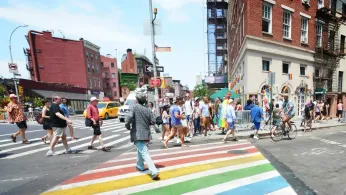
4 hours ago
Texas Follows Florida and Orders Removal of Rainbow Crosswalks
READ TIME: 4 MIN.
Texas Governor Greg Abbott has directed the Texas Department of Transportation (TxDOT) and local municipalities to remove rainbow-painted crosswalks in cities across the state. The order, issued this week, references newly emphasized federal guidelines under the SAFE Roads initiative, which restrict non-standard road markings and symbols deemed unrelated to explicit traffic safety functions. The move has ignited a debate over public space, safety, and LGBTQ+ visibility, drawing national attention to the status of longstanding pride symbols in urban environments .
Rainbow crosswalks, especially in areas like Houston’s Montrose neighborhood, have served as prominent markers of LGBTQ+ history and resilience. Montrose, recognized as one of the United States’ earliest and most visible LGBTQ+ enclaves, installed its rainbow crosswalks in 2017. The project was driven by local LGBTQ+ leaders and organizations, aiming to both increase pedestrian safety and honor the area’s role in Houston’s LGBTQ+ history .
Jack Valinski, President of the Montrose Super Neighborhood, emphasized that the crosswalks were a direct response to a fatal accident at the intersection, as well as a symbol of the area’s unique culture: “The community wanted a more visible crosswalk, and the rainbow symbolized who we are," Valinski stated .
Governor Abbott’s directive followed a letter from U.S. Transportation Secretary Sean Duffy, urging states to comply with the federal SAFE Roads initiative. The guidelines require that all crosswalks and road markings remain free from political or ideological messaging and avoid visual distractions, limiting colors and symbols to those prescribed in the Manual on Uniform Traffic Control Devices (MUTCD) .
Governor Abbott justified the removal by stating, “Texans expect their taxpayer dollars to be used wisely, not advance political agendas on Texas roadways. To keep Texans moving safely and free from distraction, we must maintain a safe and consistent transportation network across Texas” . The Governor further warned that cities failing to comply could face suspension of state and federal road funding, as well as the withdrawal of agreements with TxDOT .
TxDOT issued a statement confirming its intention to implement the order: “Pavement markings such as decorative crosswalks, murals, or markings conveying artwork or other messages are prohibited on travel lanes, shoulders, intersections, and crosswalks unless they serve a direct traffic control or safety function. This prohibition includes the use of symbols, flags, or other markings conveying any message or communications” .
The directive has prompted varied responses among Texas cities:
- In Houston, the Metropolitan Transit Authority (METRO) confirmed it will comply with the removal order, stating the Montrose crosswalks will be repainted within 28 days. Protest signs have appeared at the intersection, reflecting local opposition to the change .
- Dallas officials, whose Oak Lawn neighborhood also features rainbow crosswalks, are reviewing the governor’s order before determining their next steps. The original painting in Dallas was funded by a local advocacy chapter rather than taxpayer dollars, but the city retains ownership of the pavement .
- In San Antonio, local LGBTQ+ organizations, including the area’s Pride Cultural Heritage District, have indicated readiness for legal action to preserve their crosswalks. San Antonio’s mayor has met with the city attorney and is awaiting further guidance from TxDOT .
- Austin officials stated they will comply with the governor's guidelines but are assessing which locations will be affected based on the specifics of the directive .
Houston’s LGBTQ+ community and allied organizations have expressed deep concern and disappointment over the directive. The Montrose Center, one of Houston’s largest LGBTQ+ resource organizations, characterized the order as a setback for LGBTQ+ visibility and inclusion, emphasizing the importance of public symbols in affirming community identity .
“Symbols like the rainbow crosswalks are more than just paint. They are statements of belonging, safety, and pride for all who live, work, and visit our neighborhoods,” the Montrose Center stated. Local leaders also stressed that the crosswalks had practical origins tied to public safety and that their removal undermines longstanding efforts to make high-traffic intersections safer for pedestrians .
National LGBTQ+ advocacy groups have connected the episode to broader debates around the protection of LGBTQ+ spaces and symbols, especially in the context of rising anti-LGBTQ+ rhetoric and policies in the United States. They argue that such actions risk erasing public affirmation for marginalized groups and can contribute to hostile or unsafe environments, particularly for transgender people, youth, and other vulnerable populations .
Legal experts note that the order’s reliance on federal safety guidelines, rather than explicit anti-LGBTQ+ intent, may complicate challenges on constitutional or civil rights grounds. However, cities like San Antonio have signaled possible legal opposition, arguing that the crosswalks serve legitimate community and cultural purposes beyond any political message .
Municipal leaders are also weighing the financial risks of non-compliance, given the potential loss of state and federal transportation funding as outlined by the governor .
The fate of Texas’s rainbow crosswalks remains uncertain as cities deliberate compliance, legal options, and community engagement strategies. The episode has revived discussions on the role of public art and symbols in fostering inclusive, welcoming environments for all residents. For many in the LGBTQ+ community, the removal of these crosswalks represents not just the loss of artwork, but a challenge to the ongoing struggle for visibility, safety, and affirmation in public life .






